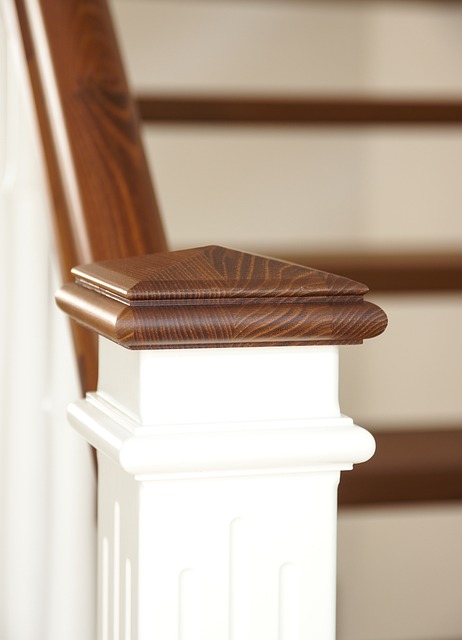Industrial-style staircases, characterized by their spiral or helical designs, have become popular for small spaces due to their space-saving efficiency and striking aesthetics. Rooted in history yet revolutionized by modern metalworking, these stairs offer customization, durability, and low maintenance. When designing them, focus on structural integrity with robust metalwork, incorporate weather-resistant materials like stainless steel or aluminum, and carefully consider balustrades and handrails for safety. They seamlessly integrate into various architectural styles, adding texture and character to spaces like loft conversions or warehouse homes. Prioritizing safety through planning and regular maintenance ensures these staircases remain functional and appealing while complying with building codes.
Spiral or helical iron staircases offer a unique and elegant solution for smaller spaces, providing both functionality and a bold architectural statement. These space-saving designs have gained popularity due to their compact form and ability to enhance narrow areas. This article explores the history and definition of spiral/helical stairs, delving into their numerous benefits, especially in industrial-style interiors. We’ll guide you through key design elements, suitable architectural styles, and essential installation, safety, and maintenance tips for these distinctive iron staircases.
Understanding Spiral and Helical Iron Stairs: Definition and History
Spiral and helical iron stairs are unique architectural elements that have captivated designers and homeowners alike for centuries. These curvaceous structures, often characterized by their compact size and elegant design, offer a distinct alternative to traditional staircases. The concept dates back to ancient times when architects incorporated spiral steps into monumental buildings, but it was during the Industrial Revolution that metalworking techniques advanced, allowing for more intricate and accessible iron staircase designs.
Industrial-style staircases, in particular, have seen a resurgence in popularity due to their ability to blend functionality with striking aesthetics. The spiral or helical design efficiently utilizes space, making them ideal for smaller areas where straight, linear stairs might not be feasible. This innovative approach not only adds a touch of sophistication but also creates a focal point within a room, contributing to the overall unique character of a space.
Benefits of Industrial-Style Staircases in Smaller Spaces
In smaller spaces, choosing the right staircase can make or break the design aesthetic and functionality. Industrial-style staircases offer a unique blend of elegance and space-saving benefits, making them an excellent choice for compact areas. These staircases often feature spiral or helical designs, which not only save valuable floor space but also create a striking visual statement. The industrial look, characterized by raw materials like metal and exposed structure, adds character and depth to the interior, transforming a small space into a cozy yet stylish abode.
Furthermore, industrial-style staircases are known for their versatility and adaptability. They can be customized to fit various dimensions and design preferences, ensuring that each installation is one of a kind. The durability and low maintenance requirements of these staircases make them a practical choice for those seeking both style and substance in their smaller spaces.
Key Design Elements for Elegant Space-Saving Stairs
When designing elegant, space-saving iron staircases with a spiral or helical shape for smaller spaces, several key elements come into play. The first is the industrial-style staircase‘s structural integrity; since these stairs often twist and turn, robust metalwork is essential to ensure safety and longevity. Smooth, curved lines enhance the aesthetic appeal while maintaining functionality, creating a striking visual statement that doesn’t dominate the room’s space.
Materials play a crucial role too. Opting for weather-resistant, low-maintenance metals like stainless steel or aluminum guarantees long-lasting beauty without regular upkeep. Balustrades and handrails should be carefully considered to maintain both safety and the desired design flow. Minimalist, modern styles can complement smaller spaces, while decorative elements like intricate patterns or unique finishes add character to larger, more expansive areas.
Incorporating Spiral/Helical Stairs into Different Architectural Styles
Spiral and helical iron staircases offer a versatile design element that can seamlessly integrate into various architectural styles, adding both functionality and aesthetic appeal. In contemporary homes with open-concept living areas, these unique staircases can serve as a striking focal point while efficiently utilizing limited space. Their sleek lines complement modern aesthetics, creating a dramatic entrance or connecting different levels in a stylish manner.
For those favoring a more industrial-style staircase, raw iron and metal spiral designs can be a perfect fit. These staircases often feature exposed steel elements, adding texture and a robust character to the interior. In loft conversions or warehouse-inspired spaces, such industrial-style staircases enhance the raw, urban charm while providing easy navigation between floors. Incorporating these designs allows architects and designers to create dynamic spaces that defy traditional layout conventions, ensuring each home or building makes a unique architectural statement.
Installation, Safety, and Maintenance Considerations
Spiral or helical iron staircases, with their elegant and space-saving designs, are a unique architectural statement for smaller spaces. When considering installation, safety should always be paramount. These industrial-style staircases require careful planning and adherence to local building codes to ensure structural integrity and compliance. Regular maintenance is crucial to prolong the lifespan of the staircase, involving periodic inspections, repainting or coating to prevent corrosion, and lubricating moving parts for smooth operation. By addressing these considerations, homeowners can enjoy the aesthetic appeal and functional benefits of spiral staircases while maintaining a safe living environment.
Spiral and helical iron staircases offer a captivating blend of aesthetics and functionality for smaller spaces, elevating them from mere passageways to striking architectural focal points. Their elegant, space-saving designs not only maximize limited real estate but also inject a dose of industrial chic into any interior. By understanding the historical context, embracing their benefits, and paying attention to key design elements, installation considerations, and safety aspects, homeowners and designers can incorporate these unique structures seamlessly into various architectural styles, creating both a statement and a practical solution for compact living spaces.
